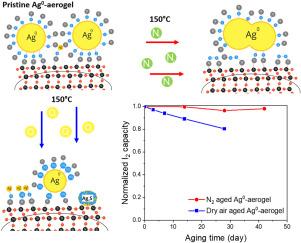Influence of elevated temperature and oxygen on the capture of radioactive iodine by silver functionalized silica aerogel
IF 4.7
3区 材料科学
Q1 CHEMISTRY, APPLIED
引用次数: 0
Abstract
Reprocessing is considered a competent strategy for spent nuclear fuel management, yet radioiodine (129I) is emitted in reprocessing off-gas as a hazardous byproduct. Silver functionalized silica aerogel (Ag0-aerogel), a promising iodine capture material, experiences a reduction in its capacity after prolonged exposure to off-gas components at elevated temperatures, a phenomenon termed as aging. To fully understand this process, we isolated the contribution of each aging factor, exposing Ag0-aerogel samples to N2 and dry air gas streams, respectively, at 150 °C for different time periods. Aged samples were loaded with I2 to examine the capacity change and comprehensively characterized to investigate the evolution of their properties. Results show that temperature alone did not alter Ag0-aerogel's capacity but triggered Ag0 nanoparticles sintering and generated organic sulfur species. The presence of O2 reduced the capacity by ∼20 %, causing (i) formation of silver sulfide (Ag2S) crystals and (ii) oxidation of Ag-thiolate (Ag-S-r) to Ag sulfonate (Ag-SO3-r). Given that Ag2S readily adsorbs I2, the formation of Ag-SO3-r is the major inhibitor for iodine adsorption. This hypothesis was supported by density functional theory (DFT) simulations. These findings unraveled key mechanisms of Ag0-aerogel aging, which are useful in the development of materials that withstand realistic spent-nuclear-fuel-reprocessing off-gas conditions.

高温和氧气对银功能化二氧化硅气凝胶捕获放射性碘的影响
后处理被认为是一种有效的乏核燃料管理策略,但放射性碘(129I)作为一种有害的副产品在后处理废气中排放。银功能化二氧化硅气凝胶(Ag0-aerogel)是一种很有前景的碘捕获材料,但在高温下长期暴露于废气成分后,其捕获能力会下降,这种现象被称为老化。为了充分了解这一过程,我们将 Ag0-aerogel 样品分别暴露在 150 °C 的 N2 和干燥空气气流中,并在不同的时间段内分离出每个老化因素的作用。老化后的样品装入 I2 以检测其容量变化,并对其进行全面表征以研究其特性的演变。结果表明,温度本身不会改变 Ag0 气凝胶的容量,但会引发 Ag0 纳米颗粒烧结并产生有机硫物种。O2 的存在使容量降低了 ∼20 %,导致 (i) 硫化银(Ag2S)晶体的形成和 (ii) Ag-thiolate (Ag-S-r) 氧化为 Ag sulfonate (Ag-SO3-r)。鉴于 Ag2S 很容易吸附 I2,Ag-SO3-r 的形成是碘吸附的主要抑制剂。这一假设得到了密度泛函理论(DFT)模拟的支持。这些发现揭示了 Ag0 气凝胶老化的关键机制,有助于开发能承受现实乏核燃料后处理废气条件的材料。
本文章由计算机程序翻译,如有差异,请以英文原文为准。
求助全文
约1分钟内获得全文
求助全文
来源期刊

Microporous and Mesoporous Materials
化学-材料科学:综合
CiteScore
10.70
自引率
5.80%
发文量
649
审稿时长
26 days
期刊介绍:
Microporous and Mesoporous Materials covers novel and significant aspects of porous solids classified as either microporous (pore size up to 2 nm) or mesoporous (pore size 2 to 50 nm). The porosity should have a specific impact on the material properties or application. Typical examples are zeolites and zeolite-like materials, pillared materials, clathrasils and clathrates, carbon molecular sieves, ordered mesoporous materials, organic/inorganic porous hybrid materials, or porous metal oxides. Both natural and synthetic porous materials are within the scope of the journal.
Topics which are particularly of interest include:
All aspects of natural microporous and mesoporous solids
The synthesis of crystalline or amorphous porous materials
The physico-chemical characterization of microporous and mesoporous solids, especially spectroscopic and microscopic
The modification of microporous and mesoporous solids, for example by ion exchange or solid-state reactions
All topics related to diffusion of mobile species in the pores of microporous and mesoporous materials
Adsorption (and other separation techniques) using microporous or mesoporous adsorbents
Catalysis by microporous and mesoporous materials
Host/guest interactions
Theoretical chemistry and modelling of host/guest interactions
All topics related to the application of microporous and mesoporous materials in industrial catalysis, separation technology, environmental protection, electrochemistry, membranes, sensors, optical devices, etc.
 求助内容:
求助内容: 应助结果提醒方式:
应助结果提醒方式:


